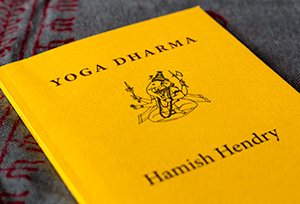
I was fortunate enough to meet Hamish outside practice in Mysore and buy a copy of his delightful Yoga Dharma. Yoga Dharma isn’t just another book for your yoga library, it stands out from the vast selection of other yoga books for a number of reasons.
First impressions
I immediately felt that Yoga Dharma has been made with much love. Three things stood out on first impressions:
- Firstly the book is instantly inviting as it’s a slight 64 pages.
- It’s bound in a warm yellow cover in soft textured paper.
- The design of Yoga Dharma is striking with a beautiful Ganesh illustration, considered typography and rich colour palette (you can tell I’m a designer can’t you?).
Yoga Dharma opens with the following lines: ‘Before you start reading this book breathe long and deep. This is the only practice in this book and may be the most important.’ Hamish describes the title Yoga Dharma as ‘that which supports’. Considering the breadth and depth of the topic on hand, Hamish has gone to great lengths to be economical with his words. The sentences feel like they’ve been lovingly whittled down removing all extraneous characters to reveal rich and deep meaning. You’ll forgive me if I get a bit poetic on your ass here but I thoroughly enjoyed Yoga Dharma.
This is a modern commentary and a primer on yoga philosophy from someone who has dedicated their life to practice and is an inspiration to others to do the same. It skips lightly over cavernous topics providing personal reflections and practical insights. The field of yoga philosophy can be baffling in its sheer scope and can leave even the hardest navel gazers feeling perplexed and confused.
Hamish does a great job of making the topic relevant to modern every day life and observes that the fruits of this internal work are evidenced in our relationships with ourselves, our family and society.
If you’ve been practising for a while and wonder what all the jumping around on the mat is about (to borrow a phrase from David Keil) then this book does a great job of surveying the topography of a rich landscape – offering wonderful and accessible insights on the various fauna and flora.
Yoga Dharma is structured into 16 parts:
- Introduction (including Sanskrit basics)
- Yoga Sutras
- Veda and Upanishad
- Katha and Isha Upanishad
- Stories: Part 1 (Ramayana)
- Stories: Part 2 (Mahabharata)
- Bhagavad Gita
- Vedanta
- Samkhya
- Hatha Yoga Pradipika
- Buddhism
- Conclusion
- Chart of the seven major chakras
- Glossary
- Four blind men and an elephant
- Recommended reading
I read the book in an afternoon but I feel like I’ve just made a new friend and we’ll be spending a lot of time together over the years. Hamish is not a digital yogi and you won’t find this book on Amazon. So, if you see him I suggest you form an orderly queue and purchase what will undoubtedly become a modern classic for the contemporary yoga student.

No comments yet.